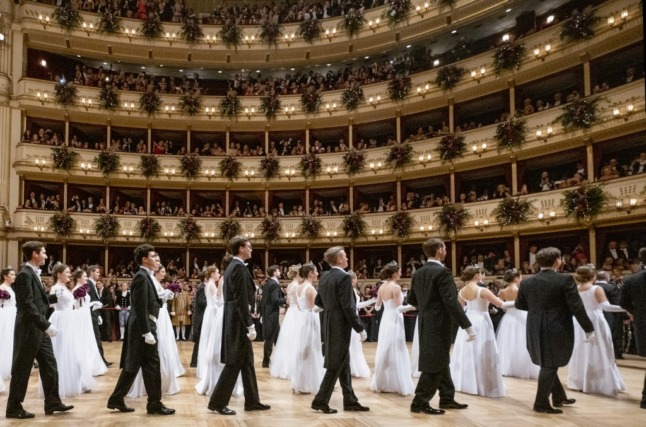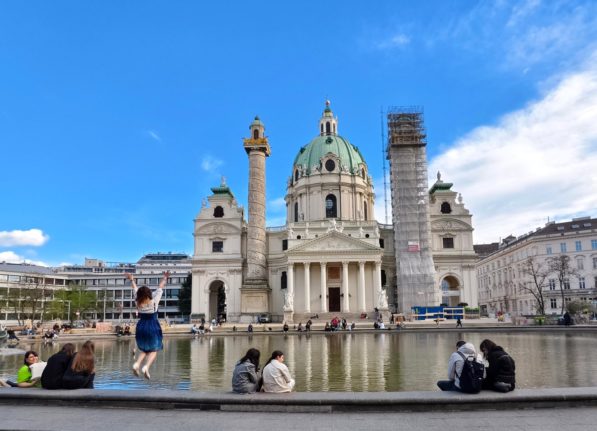Carnival is a festive period celebrated worldwide, and even if some of the most traditional or famous parties happen in Rio, Cologne or Venice, Austria also has its share of great (and old!) traditions and symbols.
The carnival period in Austria has no fixed days, as it’s determined by when Easter falls, like in other countries. In Austria, the celebrations typically happen from the Saturday before Shrove Tuesday to Ash Wednesday – this year that’s Saturday, February 10th until Wednesday, February 14th.
The dates may vary, but the much-beloved traditions tend to stay the same with many focused on “scaring away” winter and welcoming spring.
Carnival food

These jam-filled doughnuts are a symbol of carnival. The typical Viennese Faschingskrapfen will have a sticky apricot jam inside, and this filling should make up at least 15 percent of the entire doughnut, according to strict Krapfen standards.
READ ALSO: Everything you need to know about Faschingskrapfen
Krapfen is also an excellent example of the differences between German and Austrian German. For instance, in an Austrian bakery, it’s best not to call the Krapfen by its German name: Berliner Pfannkuchen.
But there’s a lot more to carnival than food; for many people, carnival just wouldn’t be carnival without the dressing up.
At the peak of the celebrations, usually on Faschingsdienstag (Shrove Tuesday), there are several parties all over the country, with many people donning all kinds of witty and creative costumes and intricate masks informed by local traditions.
But while the celebrations share a common theme, events differ across the country with each Austrian state having its own traditions.
Traditions around Austria
Styria, for example, is known for its annual carnival race, the Faschingsrennen, where participants wearing traditional costumes run up to the highest spot in town to “scare away the winter” – loud noises are part of the scare tactics, of course.
Tyrol has some rather eyebrow-raising traditions, featuring figures like “Roller” (named after the costume’s rotating bells) or “Scheller” (who carries big bells). The two different characters symbolise elegance and strength and wear massive crowns while walking around loudly ringing the bells on their belts.
The traditional masked Schleicherlaufen parade is also in Tyrol and is held every five years. The “Schleicher” are the 40 men who parade in huge hats, some of which weigh as much as 8 kilogrammes.
The parade has taken place in the state since 1890 and was given Unesco World Cultural Heritage status in 2010.
Some local events, such as the Blochziehen, take place only every four years – the last one was in 2023. Here, masked villagers carry a 30-metre-long pine log through town to symbolise the coming of spring.
Tyrol has so many quirky events that it would be hard to list them all, but the Wampelerreiten in Axams near Innsbruck is also very popular, with the Wampeler (meaning fat-belled) – young men wearing black hats, masks and padded white shirts – taking part in a battle against the Riders who try to dirty the Wampeler’s white shirts.
According to tradition, the fewer shirts that get soiled in the battle, the better the harvest will be.
Vorarlberg is famous for its Feldkircher Fastnachtsumzug, a procession of people wearing brightly coloured costumes who welcome spring with loud singing and traditional songs. They scare away winter using torches creating beautiful visuals.
Upper Austria is known for the Ebensee Carnival Parade, which takes place on the Monday before Shrove Tuesday. The procession is attended by people wearing older women’s clothes, a rag hat, and a creepy-looking wooden mask. It’s all in good fun, though, and the celebrations usually last until late at night – the party and festival became a Unesco World Heritage Site in 2011.
Carinthia is home to the Villacher Fasching with parties that are even broadcast by Austrian TV channel ORF. You will often hear the traditional carnival exclamation “Lei Lei!,” based on traditions from Middle Ages and similar to the famous “Alaaf!” in Cologne.

Vienna’s carnival typically coincides with the capital’s ball season. The city may not be home to the old carnival traditions of Austria’s western villages, but there is still much beauty and entertainment to be seen and had here.
The most famous ball is the Vienna Opera Ball, which has been held in the Vienna State Opera House for over 60 years. Every Viennese will tell you that this is the “world’s most beautiful ballroom,” with debutant couples dancing and more than 5,000 guests attending.
The Krapfen is also most famous in Vienna and it is consumed in copious quantities here. It’s a tradition that’s taken seriously, too, and the pastries are expected to have at least six fresh egg yolks in every kilogramme of flour, the only way for it to be fluffy on the inside but crispy on the surface – just as it should be.
READ ALSO:



 Please whitelist us to continue reading.
Please whitelist us to continue reading.
Member comments